Abstract
As water scarcity and pollution increase in rural communities in some parts of developing countries, there is a need to find simple ways to improve the quality of contaminated water. In this research, bagasse-based cellulose membranes were prepared and evaluated in a simple filtration system and compared with polycaprolactone membranes (PCL) and bagasse-based cellulose/PCL membranes for the removal of total coliform bacteria, Escherichia coli and other physical and chemical contaminants from contaminated water. Cellulose offers many opportunities in filtration technology due to its physical and chemical characteristics that allow its use in the design of membranes with flexible capabilities and specific applications. The membranes were characterized physically, chemically and mechanically, finding similarity in mechanical properties and differences in porosity. The membranes were tested in a filtration system and PCL membranes were more effective in removing turbidity (94.5%), color removal (70%) and phosphorus removal (50%), while cellulose membranes were better at retaining fecal coliforms (84.5%) and E. coli (90.8%). Statistical analysis (one-way ANOVA, p < 0.05) confirmed significant differences among the three membrane types for turbidity, apparent color, and nitrate, while no significant differences were observed for pH, conductivity, and phosphorus. These results suggest that the use of the membranes could help to improve the quality of polluted water and more studies are needed in order to improve their efficiencies.
1. Introduction
Water scarcity exposes the human population to inadequate water sources in rural areas of developing countries, necessitating the development of simple new technologies to improve water quality. One group of pollutants of great concern due to its acute impact to human health are pathogenic microorganisms which might be present in water or poorly treated wastewater [1]. Pathogenic microorganisms are responsible of hydric diseases such as typhus, cholera, dysentery, etc. Coliform bacteria, specifically fecal coliform bacteria and/or Escherichia coli bacteria are used to evaluate the presence of pathogenic microorganisms in water, that is, if the water has been in contact with human waste; as it would represent a health risk due to the possibility of waterborne diseases [2]. Fecal coliforms are universally present in large quantities in the feces of humans and warm-blooded animals [3], while E. coli is the key species of the fecal coliform group, representing more than 90%, and therefore, is a definitive indicator of fecal contamination in water and a strong indicator of recent contamination with sewage or animal feces [4,5,6].
On the other hand, cellulose is the world’s most abundant natural polymer, with an estimated annual production of around 1.5 × 1012 tons [7].Cellulose is characterized as a linear polymer composed of repeating units of anhydroglucose rings connected by β-1,4 glycosidic bonds. The organization of cellulose chains is achieved thanks to extensive intra- and intermolecular hydrogen bonds and Van der Waals forces that are established between adjacent hydroxyl groups and oxygen atoms [8]. Given its characteristics, such as mechanical properties, renewability, ability to be compatible with biological systems, ease of natural degradation and chemical stability, cellulose has become a resource of choice to strengthen polymeric compounds and develop environmentally friendly materials [9,10].
One notable area where cellulose-derived products show great potential is in water treatment [11,12]. This effectiveness is largely attributed to the surface chemistry of cellulose, as its abundant hydroxyl groups (-OH) provide active sites for hydrogen bonding and electrostatic interactions with heavy metals, dyes, and microbial cell surfaces, thereby enhancing contaminant adsorption and retention [12]. The use of cellulose-based materials in the removal of contaminants has been widely studied, and research on cellulose nanocrystals (CNC) and chemically modified cellulose nanofibers (CNF) with periodate and chlorite oxidation, as well as sulfonation, have been reported with the aim of converting them into effective flocculants for the treatment of municipal wastewater through coagulation-flocculation processes in combination with ferric coagulants, proving to be successful in reducing turbidity [13]. Other studies have focused on evaluating the adsorption of contaminants focusing mainly on dyes [14,15,16,17,18] and heavy metals [19,20,21]. In these studies, cellulose has been evaluated as a composite material with other polymer matrices, in order to improve structure and mechanical properties such as the formation of networks between fibers that increased porosity and water flow [22,23].
For dye removal, cellulose membranes and composites have demonstrated strong adsorption capacity and color removal efficiency due to hydrogen bonding and electrostatic interactions with anionic dyes [14,15,16]. In the case of heavy metals, cellulose-based materials have been shown to remove ions such as Pb2+, Cu2+, and Cd2+, mainly through ion exchange and surface complexation mechanisms [19,20,21]. In many of these cases, cellulose was combined with other polymer matrices to enhance structural and mechanical properties, for example, through the formation of fiber networks that increased porosity and improved water flow [22,23]. More recently, cellulose membranes have also been investigated for microbial removal, where their surface charge and roughness facilitate the adhesion and retention of bacteria, thereby improving the microbiological quality of water [11,12]. Collectively, these findings demonstrate the versatility of cellulose as a platform for membrane design and highlight its potential for addressing multiple types of contaminants in water purification.
Despite the relevance of bacterial indicators of the microbiological quality of water, to date there are few studies on the removal of viruses and bacteria by using materials derived from celluloses [24,25,26,27]. Cellulose nanofiber composite membranes were tested by assembling an electrospun cellulose nanofabric layer as a mechanical support and a regenerated cellulose gel membrane coating as a barrier. These membranes were able to remove particles as small as 50 nm, suggesting their potential application in virus removal [25]. It has been reported that cellulose-based paper filters modified with single layers of the polyelectrolyte polyvinylamine polymer and multilayers of the polyelectrolyte polyacrylic acid can remove bacteria from water by enhancing electrostatic interactions. These filters achieved removal efficiencies of more than 97% for cultivable bacteria and 99.9% for E. coli added to the water [28]. Other investigation tested membranes composed of zeolite and cellulose and evaluated the removal of different types of bacteria (total coliforms, Escherichia coli, Enterococci and Clostridium) finding high removal values for less than 100 colonies per 100 mL [27]. These works demonstrate the versatility of cellulose in the elimination of microbiological contaminants from synthetic waters.
Although cellulose has been widely recognized as a promising material for membrane fabrication due to its abundance, biocompatibility, and surface chemistry, most reported studies have focused on synthetic wastewaters or model contaminants. In contrast, research addressing the performance of cellulose-based membranes in removing microbial contaminants from real or semi-real contaminated water remains scarce. This gap highlights the need for evaluating cellulose membranes under conditions that more closely reflect real scenarios. At the same time, it is necessary to explore less complex fabrication routes for cellulose composite membranes and assess their performance in polluted waters. In this context, the use of waste-derived materials, such as agave bagasse, represents not only a sustainable source of cellulose but also an opportunity to contribute to the circular economy while improving water quality in rural communities of developing countries [29].
Based on these considerations, the aim of this preliminary study was to compare bagasse-derived cellulose membranes with polycaprolactone (PCL) membranes for the removal of total coliforms, E. coli, and other physicochemical contaminants typically present in polluted surface waters used for human consumption in developing countries. PCL contributes complementary properties, including hydrophobicity and high mechanical stability: its hydrophobic character reduces water uptake and fouling, while its tensile strength and elasticity enhance durability and support high water fluxes during filtration cycles [30,31]. The integration of these features with the chemical functionality of cellulose enables the design of membranes with synergistic performance, suitable for both bacteriological and physicochemical purification. Furthermore, bagasse—an abundant by-product of the tequila industry with limited current applications—represents a sustainable source of cellulose that can be readily extracted for membrane fabrication. This preliminary study thus provides a foundation for developing affordable and scalable filtration technologies, particularly adapted for regions with limited access to conventional purification systems. The implementation of such low-cost membranes in simple filtration units could play a critical role in protecting human health in rural communities of developing countries.
2. Materials and Methods
2.1. Preparation and Characterization of the Cellulose-Based Membranes
Cellulose was obtained from bagasse agave according to the methodology described in previous works that includes steps as organosolv pulping, bleaching and microfluidization of cellulose [32,33]. Organosolv pulping was using an ethanol/water solution (60:40 v/v) with 1% (w/v) and acetic acid as catalyst. The treatment was carried out at 180 °C for 90 min. All reagents used were analytical grade (ethanol ≥ 99.5%, acetic acid ≥ 95–97%, Sigma-Aldrich, St. Louis, MO, USA). Agave bagasse cellulose fiber membranes were prepared according to the TAPPI T205 manual sheet preparation standard [34]. The TAPPI T205 method involves dispersing cellulose fibers in water to form a uniform membrane on a mesh mold. The water is drained, and excess water is removed by pressing between felts, and finally, the membrane is dried under controlled conditions (Figure 1).
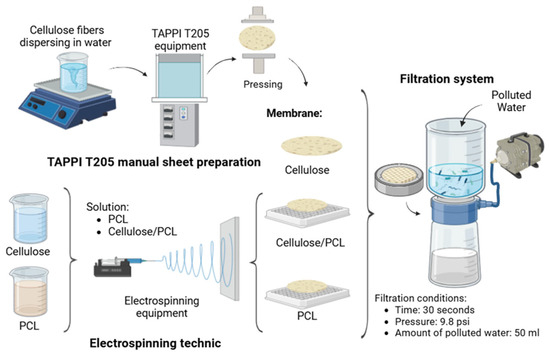
Figure 1.
Representation of the preparation of the cellulose-based membranes and filtration system.
The preparation of the polycaprolactone (PCL) and Cellulose/PCL membrane was carried out by electrospinning technic and using polycaprolactone (molecular weight = 80,000, GPC and melt viscosity ASTM D1238:73) and cellulose fibers obtained from agave bagasse. (Figure 1). PCL was dissolved in chloroform (≥99.8%, Sigma-Aldrich) (40% w/v), while cellulose were dispersed in dimethylformamide (DMF; ≥99.8%, Sigma-Aldrich) at 2.5% w/v. The cellulose dispersion was shaken for 24 h and then sonicated for 30 min before being blended with the PCL solution. A composite solution with a PCL/cellulose ratio of 50:50 (v/v), as well as a pure PCL solution, was electrospun under a voltage of 15–20 kV, with a flow rate of 0.5 mL/h and a tip-to-collector distance of 20 cm, following previous studies [21]. During the process, the solvent evaporated and ultrafine fibers were deposited on the collector, forming a porous membrane. Three types of membranes were prepared according to the concentration % (Table 1).

Table 1.
Cellulose-based membranes and polycaprolactone.
The characterization of the membranes was performed by Fourier-transform infrared spectroscopy (FTIR), Scanning electron microscope (SEM) and Tensile properties. FTIR analysis was carried out to determine the main functional groups on the membranes. The FTIR spectra were collected at a resolution of 4 cm−1 in transmission mode (4000–400 cm−1) using an FTIR spectrophotometer Alpha, Bruker (Berlin, Germany). The spectra were plotted using Origin Pro 2019 software. With regard to the SEM, it was used to determine the porosity and fiber diameter of the membranes. The scanning electron microscopy (SEM) using a TESCAN MIRA 3 LMU (TESCAN, Brno, Czech Republic). The samples were coated with a thin layer of gold prior to observation, and micrographs were obtained at an accelerating voltage of 15–20 kV. The images obtained in SEM were analyzed with the software ImageJ 1.45. Finally, the tensile properties were measured on 0.5 mm thick × 12 mm wide × 50 mm long strips of the membranes using a universal testing machine Instron 5967, 50-N load cell (Norwood, MA, USA) at a crosshead speed of 5 mm/min. The measurements for each sample were carried out in triplicate. Young’s modulus was calculated by dividing the tensile stress by the engineering extensional strain, in the elastic (initial, linear) portion of the stress–strain curve.
2.2. Filtration Tests with Cellulose-Based and Polycaprolactone Membranes
The filtration tests were carried out with membranes of 210 mm diameter and 0.25 mm thickness. Each type of membrane was placed inside a Gooch crucible that was mounted in a Kjeldahl flask connected to a 1 HP WELCH vacuum pump with a maximum pressure of 9.8 psi. A volume of 50 mL of contaminated water was filtered in 30 s. For each type of membrane, tests were performed in triplicate (Figure 1).
2.3. Water Quality Parameters
To evaluate the membranes for the removal of some specific contaminants commonly found in surface waters used as sources of drinking water in developing countries [35], contaminated tap water was prepared by mixing tap water and settled domestic wastewater (taken from the facilities of the University of Guadalajara Ciénega Campus) in a ratio of 1:10 (v/v). In this way, the presence of the contaminants of interest was guaranteed. One liter of contaminated water was prepared. Quality parameters of the contaminated water were evaluated before and after being filtered in the filtration system and included: pH, turbidity, apparent color, nitrate, reactive phosphorus, total coliforms and Escherichia coli. A Thermo Scientific™ ORION STAR A215 m (Thermo Fisher Scientific, Waltham, MA, USA) was used to determine pH and conductivity. For turbidity measurements, a HANNA turbidimeter model: HI 03703 was used with a reading range of 0.00 to 1000 nephelometric turbidity units (NTU). To determine the apparent color and true color, as well as the nitrate and reactive phosphorus content, a HACH DR6000 spectrophotometer (Hach Company, Loveland, CO, USA) was used. Total coliforms and E. coli were quantified by the Colilert method (IDEXX Laboratories, Inc., Westbrook, ME, USA). Colilert simultaneously detects total coliforms and E. coli in water. It is based on IDEXX’s patented defined substrate technology. All the procedures were performed according to the standards for the analysis of water and wastewater [36].
The tests were performed in triplicate, and statistical significance was assessed to compare the three types of membranes. For this purpose, a one-way analysis of variance (ANOVA) was conducted (p < 0.05), followed by Tukey’s post hoc test to identify pairwise differences. All statistical analyses were carried out using Origin statistical software, version 9.0.
3. Results and Discussion
3.1. Characteristics of Cellulose-Based Membranes
As mentioned above, the membranes were characterized chemically, physically and mechanically. Figure 2 shows the FTIR spectrum of the prepared membranes where the characteristic peaks of the functional groups present in each membrane can be observed. It is highlighted that membranes containing polycaprolactone (PCL and PCL/Cellulose) present a well-marked peak at 1721 cm−1 that corresponds to the carbonyl group (C=O) of PCL. The peaks at 2945 cm−1 and 2860 cm−1 correspond to asymmetric and symmetric CH2 stretching. The bands at 1460 cm−1, 1243 cm−1 and 1176 cm−1 are related to C–C bending, asymmetric and symmetric C–O–C stretching [21,37]. On the other hand, the cellulose membranes show characteristic peaks of lignocellulose material such as a peak in the region of 3335 cm−1 that corresponds to the hydroxyl groups (OH-) and a slight peak at 2895 cm−1 corresponding to the stretching of C-H and the peaks at 1140 cm−1 and 1060 cm−1 that are attributed to groups C–C and C–O [32].
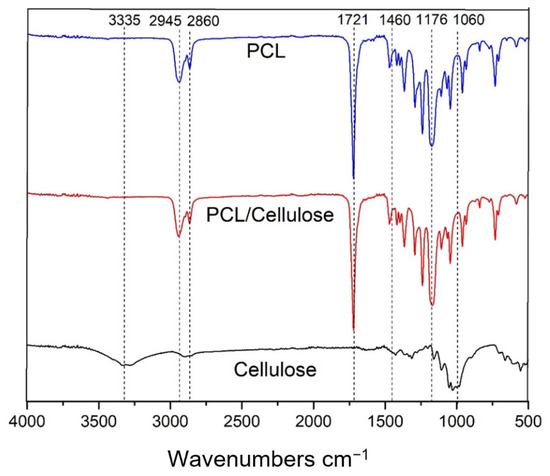
Figure 2.
FT-IR spectra of the membrane of PCL, PCL/Cellulose and Cellulose.
In the PCL/Cellulose composite membranes, the FTIR spectra showed the coexistence of characteristic bands of both polymers, suggesting physical interactions between their functional groups. Cellulose provides abundant hydroxyl (–OH) groups, while PCL contributes carbonyl (C=O) groups from its ester moieties and C–H stretching from its aliphatic chains. The broad –OH stretching band of cellulose (~3330 cm−1) may form hydrogen bonds with the C=O groups of PCL (~1730 cm−1), which could slightly shift or broaden these bands in the composite spectrum. Such hydrogen bonding has been reported to improve compatibility between hydrophilic and hydrophobic phases, leading to better fiber formation and mechanical integrity in blended membranes. Therefore, the FTIR analysis supports the presence of intermolecular interactions that stabilize the PCL/Cellulose composite membranes.
The physical characteristics of the membranes can be observed in the SEM images of Figure 3. It is observed that the three types of membranes are made up of a network of intertwined fibers that generate porosity in the structures [23,38]. Another important characteristic is the size of the fibers. As seen in Figure 3a, the cellulose membranes present thicker fibers with an average diameter of 14.63 ± 5.82 µm. The membranes in Figure 3b of PCL/Cellulose fibers are about 2.37 ± 0.84 µm and the PCL membranes in Figure 3c are about 0.43 ± 0.16 µm (Table 2).
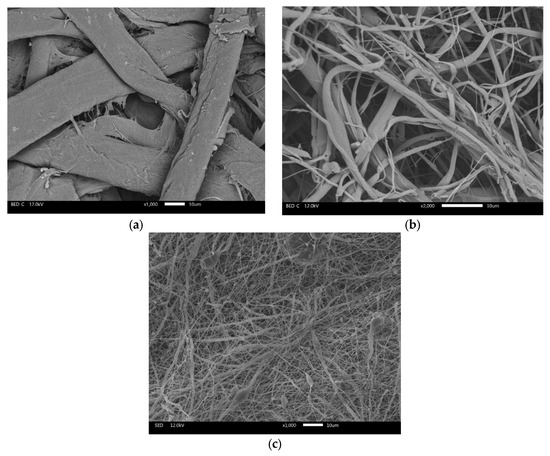
Figure 3.
SEM image of the membrane: (a) Cellulose; (b) PCL/Cellulose and (c) PCL.

Table 2.
Morphological characteristics of the membranes.
The difference in fiber size in the membrane structure influences its porosity, as seen in Table 2. Therefore, PCL membranes that have thinner fibers (0.43 ± 0.16 µm) have larger, small pores with a diameter of 1.96 ± 0.74 µm and an abundance of 277,791.29 pores/cm2 and cellulose fiber membranes that are thicker have fewer pores 6263.86 pores/cm2 and a diameter greater than 26.63 ± 11.64 µm. The large variation in pore size observed for cellulose-only membranes (Figure 3a) is primarily attributable to the TAPPI sheet-forming route, where fiber networks are created by gravity-driven deposition and subsequent drying. This process leads to random fiber orientation, floc formation, and capillary-drying effects that generate irregular pore geometries. In contrast, PCL and PCL/Cellulose membranes (Figure 3b,c) were produced by electrospinning, which enables tighter control over fiber diameter and packing through the solvent system and processing parameters (polymer concentration, applied voltage, flow rate, and tip-to-collector distance), resulting in a narrower pore-size distribution. Membrane porosity is a key factor influencing the relationship between permeability and contaminant retention [39]. A more porous material allows for greater permeate flux, facilitating the passage of water through the membrane without clogging [30,40]. However, excessive porosity can reduce contaminant retention efficiency, as small particles could pass through the membrane without being captured [41]. In this study, the heterogeneous pore distribution in the membranes evaluated favored both permeability and retention, optimizing filtration without compromising the quality of the treated water.
Regarding the tensile tests, information was obtained on the resistance, deformation and Young’s modulus of the membranes as shown in Figure 4. Cellulose membranes exhibited significantly higher tensile strength (p < 0.05) compared to PCL and PCL/Cellulose membranes, as confirmed by one-way ANOVA and Tukey’s test, while no significant differences were observed between PCL and PCL/Cellulose. In contrast, Young’s modulus showed no significant variation among the three groups (p > 0.05), indicating similar stiffness under applied loads. It is important to mention that the elastic modulus represents the relationship between stress and strain, describing the rigidity of the material under loading [42]. Therefore, the three types of membranes present similar mechanical behavior to withstand operational circumstances in the filtration system. In general, the values of resistance and Young’s modulus are low (0.2–0.35 MPa) compared to other membranes reported for filtration systems such as bamboo cellulose (3.9 MPa) [38], polyacrylonitrile (PAN) (5.59 MPa) and polysulfone (PSu) 0.83 MPa [43]. However, no modification or cross-linking has been made to the proposed membranes. This could be considered to improve the mechanical strength and reusability of the membranes in future studies [44].
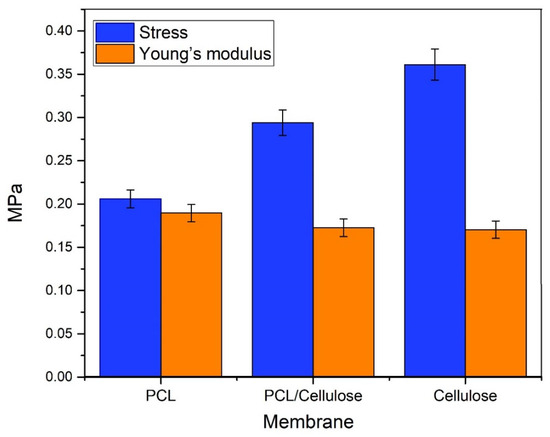
Figure 4.
Tensile properties of the membranes of PCL, PCL/Cellulose and Cellulose. Values are expressed in megapascals (MPa). Error bars indicate standard deviations.
3.2. Improvement of Water Quality When Using the Three Types of Membranes in a Filtration System
The initial characteristics of the artificially polluted water are shown in Table 3 and the reduction in pH, conductivity, turbidity and apparent color are shown in Figure 5a–d.

Table 3.
Characteristics of the polluted water used for the evaluation of the membranes.
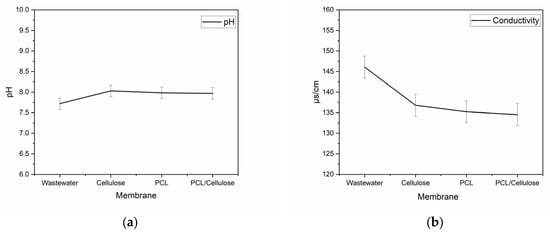
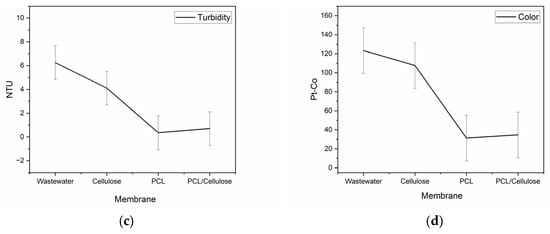
Figure 5.
Filtration Performance of remove physical parameters in wastewater: (a) pH; (b) Conductivity; (c) Turbidity and (d) Color.
As expected, the pH value did not change after the filtration process (Figure 5a). Regarding conductivity (Figure 5b), only a slight decrease was observed: the polluted water registered 146.6 µS·cm−1, which was reduced to 135.22 µS·cm−1, 134.54 µS·cm−1, and 136.8 µS·cm−1 with the PCL, PCL/Cellulose, and cellulose membranes, respectively. Turbidity (Figure 5c) decreased from 6.26 NTU to 0.35 NTU with PCL membranes (94.5% removal), 0.70 NTU with PCL/Cellulose membranes (88.8% removal), and 4.11 NTU with cellulose membranes (65.65% removal). These parameters were initially low in the artificially contaminated water due to the good quality of the tap water used, since the proportion of domestic wastewater was only 10% by volume. In another study, values of 0.0 NTU for turbidity and 72.03 ± 0.10 µS·cm−1 for conductivity were reported in the same tap water [45]. It is important to note that turbidity is a highly variable parameter, influenced not only by concentration but also by the size distribution of suspended particles. In waters with higher turbidity, greater particle loads could lead to faster membrane clogging and reduced filtration efficiency. Therefore, the proposed membranes are more suitable for tertiary treatment applications, where turbidity is already reduced in earlier stages, allowing the membranes to focus on improving physicochemical quality and microbial removal.
Statistical analysis (one-way ANOVA followed by Tukey’s test, α = 0.05) revealed significant differences for turbidity, apparent color, and nitrate among membranes, while no significant differences were observed for pH, conductivity, and phosphorus (Table S1). Tukey’s post hoc comparisons indicated that PCL and PCL/NFC did not differ significantly, whereas cellulose formed a distinct group with higher turbidity, color, and nitrate values (Table S2). In the Supplementary Figures, bars that share the same letter are not significantly different (Figures S1 and S2).
On the other hand, for apparent color (Figure 5d) the initial value was 123 Pt-Co units and the greatest decrease was with the PCL and PCL/Cellulose membrane, reaching values of 31.33 and 34.67 Pt-Co units, respectively. In this way, the removals were between 70% and 75% elimination; while with the cellulose membranes, the removal was null. It is important to emphasize that apparent color in water is due to the presence of suspended and dissolved solids [2,45]. Therefore, the low turbidity value allows us to affirm that the apparent color was mainly caused by dissolved solids, which are generally due to the presence of natural organic substances such as tannins, lignins and humic matter (especially fulfill acids) that impart a yellow-brown color to surface and ground waters [46].
Similar trends were observed for nitrate and phosphorus (Figure 6a,b). Filtration with PCL and PCL/Cellulose membranes achieved reductions of about 50% for both parameters, whereas cellulose membranes showed no reduction in nitrate and only a modest decrease in phosphorus (17%). Statistical analysis confirmed that nitrate removal was significantly higher with PCL-based membranes compared to cellulose (p < 0.001), while no differences were found between PCL and PCL/Cellulose. In contrast, phosphorus removal did not differ significantly among the three groups (p > 0.05). The removal mechanisms can be attributed mainly to size exclusion in the case of suspended or colloidal phosphate species, while dissolved nitrate removal is more likely linked to weak electrostatic interactions and surface adsorption at the polymer–water interface, particularly in PCL-based membranes. Nitrate and phosphorus are common contaminants in water and wastewater [47]. In highly polluted waters, concentrations of 5 to 10 mg L−1 might be present [2]. According to the World Health Organization guidelines, the nitrate concentration in water for human consumption is limited to 11 mg·L−1, while phosphorus has not been regulated [48]. Phosphorus is commonly found in polluted waters and can (along with nitrogen) contribute to eutrophication, promoting excessive growth of algae that decreases the oxygen available in surface waters and harms aquatic ecosystems [49].
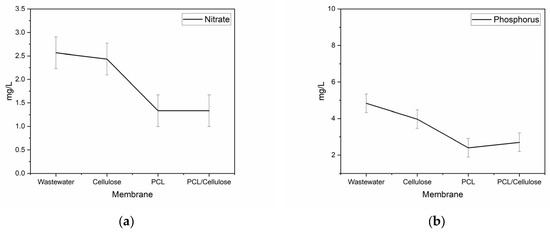
Figure 6.
Filtration Performance of remove chemical parameters in wastewater: (a) Nitrate and (b) Phosphorus.
According to the results, the effectiveness of the membranes in removing physical and chemical pollutants is strongly influenced by their structural and chemical characteristics. Cellulose membranes, with their large and fewer pores, allow higher permeability and rapid water flow but exhibit lower retention of small contaminants. In contrast, PCL and PCL/Cellulose membranes, with their smaller and more numerous pores, provide higher retention efficiency through size exclusion, which explains their superior performance in turbidity and color removal [41,50]. Beyond pore size, the surface chemistry of the polymers also plays a crucial role. The hydrophilic nature of cellulose, rich in hydroxyl groups, confers a negative surface charge in aqueous environments that promotes electrostatic interactions with positively charged contaminants and microbial components such as proteins and extracellular polymers, thereby enhancing bacterial retention [12,40]. On the other hand, the hydrophobic character of PCL reduces electrostatic interactions but prevents excessive water uptake and fouling, supporting more stable flow rates and improved durability [30,31,51]. Additionally, the partial removal of nitrates and phosphates can be attributed to weak electrostatic interactions and surface adsorption processes occurring at the polymer–water interface. Overall, these findings indicate that contaminant removal is governed not only by pore structure but also by the intrinsic surface chemistry of the membranes, with cellulose favoring microbial adsorption and PCL contributing mainly through sieving and mechanical stability.
With respect to total coliforms and E. coli removal, the results are shown in Figure 7. It is observed that the removal was higher with the cellulose membranes, this is, 84.5% and 90.8% for total coliforms and E. coli, respectively; with the PCL/cellulose membranes, the removals were 46.7 and 79.8%, respectively; and with PCL membranes, the removals were 50.1% and 72.1%, respectively. Statistical analysis confirmed significant differences among the groups (p < 0.05). Tukey’s test indicated that cellulose membranes achieved significantly higher bacterial removal than PCL-based membranes. As was mentioned previously, E. coli represent more than 90% of fecal coliforms, thus is an indicator bacterium of pollution with human waste. Furthermore, although E.coli is mostly harmless, some strains, such as E. coli O157, are pathogenic and can cause serious diseases [4]. It is important to highlight that despite the large pores of the membranes, especially the cellulose ones, compared to the size of E. coli (approximately 1–2 µm in length) [28], they showed a good capacity for bacterial removal.
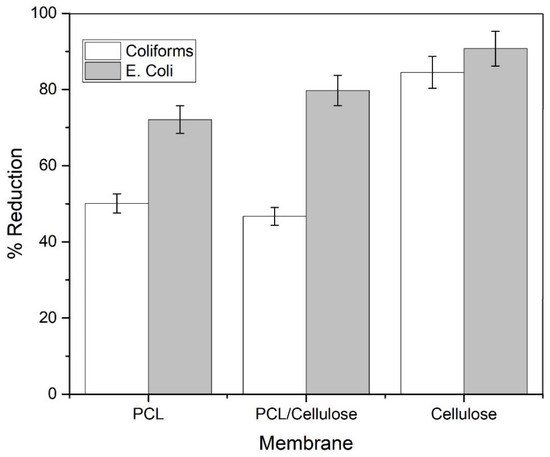
Figure 7.
Filtration Performance of % reduction in biological parameters in wastewater.
The high efficiency of cellulose membranes in removing bacteria is due to the fact that the filtration system retains contaminants due to the difference in membrane pore sizes. Bacteria are significantly larger than chemical contaminants, which facilitates their retention. On the other hand, the lower efficiency in removing chemical contaminants is due to the limited adsorption of small molecules, which can pass through the membrane without significant interactions. When analyzing the SEM images after filtration (Figure 8), it is observed that the roughness of the fibers, favored the attachment of bacteria to the surface increasing their retention (Figure 8a). In the case of PCL and PCL/Cellulose membranes, the fibers look less rough and it is observed that the bacteria remain agglomerated and retained by the porosity of the membrane (Figure 8b,c). The hydroxyl (-OH) groups of cellulose can form hydrogen bonds with the functional groups of proteins in the E. coli membrane, the polysaccharides of the bacterial capsule and with extracellular polymeric substances (EPS) produced by bacteria and this contributes to their retention on the surface of cellulose fibers [40,52]. Although no quantitative roughness data were obtained, these qualitative SEM observations and reported evidence in the literature support the role of surface roughness in enhancing bacterial adhesion [53,54].
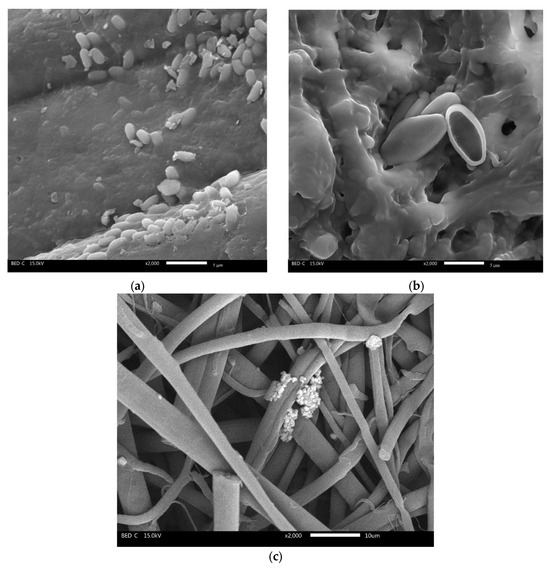
Figure 8.
SEM image of the membrane with biological contaminant: (a) Cellulose; (b) PCL/Cellulose and (c) PCL.
The removal efficiencies observed in this study are comparable with those reported for commercial and hybrid membranes. For bacteriological removal, gravity-driven ultrafiltration units with commercial polyvinylidene fluoride (PVDF) hollow fiber membranes have demonstrated 97.7–99.0% reduction in E. coli. [55], and household UF purifiers can even achieve complete removal under controlled test conditions [56]. Similarly, PAN-based nanofiber membranes have been reported to completely eliminate E. coli from contaminated water [57]. In terms of physicochemical parameters, ceramic membranes typically achieve about 99.2% turbidity reduction [58]. Taken together, these benchmarks suggest that the proposed bagasse-derived cellulose and PCL-based membranes achieve removal efficiencies within the expected ranges for polymeric and hybrid membranes, while offering the additional advantage of low cost, renewable raw materials, and simpler fabrication routes.
It is important to mention that despite the promising results obtained in this preliminary study, more in-depth studies are required to evaluate factors that could affect the efficiency of membranes in removing contaminants, such as flow rate, pressure, filtration time, and contaminant concentration. It is also necessary to assess their durability over multiple filtration cycles and to test them with real contaminated water from different sources. Even so, the present results indicate that the membranes could be used in a simple filtration system to improve the quality of water for human consumption. Membranes can be prepared with different diameters, and because of the variations in efficiency for physicochemical and bacteriological parameters, they could be applied in sequential filtration stages within the same system. For instance, cellulose membranes could be used as the first stage in a portable filter cartridge, targeting microbial removal, while PCL or PCL/Cellulose membranes could be placed after to improve physicochemical quality. This sequential arrangement could be incorporated into household cartridges for point-of-use treatment or portable filter units for rural and emergency contexts. The small size, light weight, and biodegradability of the membranes favor their integration into these systems, providing a sustainable and practical solution for decentralized water treatment.
Compared with traditional low-cost methods such as biosand filtration, activated carbon, and solar disinfection, the proposed membranes offer combined advantages. Biosand filters mainly reduce turbidity, activated carbon removes organic matter and color, and solar chlorination is effective for disinfection but depends on sunlight and does not eliminate physicochemical contaminants. In contrast, the bagasse-derived cellulose and PCL-based membranes simultaneously address microbial and physicochemical pollutants, providing a more integrated option for water treatment in rural settings. Although cellulose membranes showed high efficiency for bacterial removal, their performance in the retention of chemical contaminants was lower compared to PCL-based membranes. This limitation suggests the need for chemical or structural modification of cellulose, for example, by functionalization or cross-linking, to enhance its adsorption capacity for dissolved contaminants and to increase membrane durability. Such modifications could also improve reusability, which is an essential requirement for long-term application. The use of agave bagasse membranes in water treatment systems represents a low-cost and sustainable alternative to commercial membranes. Their production utilizes an abundant agro-industrial residue, reducing the need for synthetic materials and minimizing environmental impact. In addition, their fabrication relies on simple, energy-efficient processes that favor implementation in resource-limited communities. Being biodegradable and derived from renewable sources, these membranes do not generate persistent waste, promoting a more environmentally responsible approach to water treatment and contributing to circular economy strategies.
4. Conclusions
The three types of membranes evaluated in this study were capable of reducing the concentration of total coliforms and E. coli, although their pore size was larger than that of enterobacteria. Statistical analysis confirmed that bagasse-based cellulose membranes achieved significantly greater reductions in bacteriological parameters compared to PCL and PCL/Cellulose membranes. In contrast, PCL membranes, with small and numerous pores, significantly outperformed cellulose in the removal of physical and chemical contaminants, especially turbidity and apparent color.
The performance of the membranes in removing different pollutants was thus affected by statistically significant differences in their chemical and structural properties. SEM images showed that cellulose membranes had thicker fibers, resulting in less porous structures, while PCL and PCL/Cellulose membranes had finer fibers with a greater number of pores. This structural difference directly impacts permeability and contaminant retention capacity. These results suggest that different types of membranes could be used in sequential filtration stages to produce better quality water. They also emphasize the need for future studies to improve membrane efficiency—particularly cellulose-based membranes for bacterial removal, which were produced from an agricultural waste. These membranes offer a sustainable alternative for improving water quality in communities with limited access to conventional treatment. However, optimizing their production and evaluating their performance under real-world conditions is crucial. Their integration into decentralized systems could provide affordable and environmentally friendly solutions, with the potential to be combined with other technologies and broaden their applicability.
Supplementary Materials
The following supporting information can be downloaded at: https://www.mdpi.com/article/10.3390/environments12100355/s1, Figure S1: Group comparison boxplots for water quality parameters (pH, temperature, conductivity, turbidity, apparent color, nitrate, and phosphorus) after filtration through cellulose, PCL, and PCL/NFC membranes. The central line indicates the median, the box indicates the interquartile range, whiskers denote the minimum and maximum values, and dots represent individual data points (n = 3); Figure S2. One-way ANOVA with Tukey’s HSD (α = 0.05) results for turbidity (NTU), apparent color (Pt-Co), and nitrate (mg·L−1) in effluents filtered through cellulose, PCL, and PCL/NFC membranes. Bars represent mean ± SD (n = 3). Groups sharing the same letter are not significantly different; Table S1. Results of one-way ANOVA comparing PCL, PCL/NFC, and cellulose membranes for water quality parameters; Table S2. Tukey test of means results
Author Contributions
Conceptualization, F.Z. and B.S.-R.; methodology, A.A.-C. and H.P.-H.; formal analysis, O.H.-C. and E.M.S.-V.; writing—original draft preparation, B.S.-R.; writing—review and editing, F.Z. and B.S.-R. All authors have read and agreed to the published version of the manuscript.
Funding
This research received no external funding.
Data Availability Statement
The original contributions presented in this study are included in the article/Supplementary Materials. Further inquiries can be directed to the corresponding authors.
Acknowledgments
The author would like to thank the Secretaría de Ciencias, Humanidades Tecnología e Innovación Mexico (SECIHTI) for the support through the student maintenance scholarship.
Conflicts of Interest
The authors declare no conflicts of interest.
References
- Uprety, S.; Ngo, I.; Maggos, M.; Dangol, B.; Sherchan, S.P.; Shisler, J.L.; Amarasiri, M.; Sano, D.; Nguyen, T.H. Multiple pathogen contamination of water, hands, and fomites in rural Nepal and the effect of WaSH interventions. Int. J. Hyg. Environ. Health 2024, 257, 114341. [Google Scholar] [CrossRef]
- Boyd, C. Water Quality: An Introduction; Springer: Cham, Switzerland, 2020. [Google Scholar] [CrossRef]
- Clarke, R.; Peyton, D.; Healy, M.G.; Fenton, O.; Cummins, E. A quantitative microbial risk assessment model for total coliforms and E. coli in surface runoff following application of biosolids to grassland. Environ. Pollut. 2017, 224, 739–750. [Google Scholar] [CrossRef] [PubMed]
- Morris, C.L.; Pokhrel, L.R.; Williams, A.; Iverson, G. Understanding factors influencing total coliform and E. coli sampling outcomes in new private water wells in North Carolina, USA. Groundw. Sustain. Dev. 2022, 17, 100759. [Google Scholar] [CrossRef]
- Xu, G.; Wang, T.; Wei, Y.; Zhang, Y.; Chen, J. Fecal coliform distribution and health risk assessment in surface water in an urban-intensive catchment. J. Hydrol. 2022, 604, 127204. [Google Scholar] [CrossRef]
- Pérez Guillemette, T.; Albrechtsen, H.-J. Microbial indicators for water quality in recirculating shower technology. Sci. Total Environ. 2025, 965, 178610. [Google Scholar] [CrossRef] [PubMed]
- Acharya, S.; Hu, Y.; Abidi, N. Cellulose Dissolution in Ionic Liquid under Mild Conditions: Effect of Hydrolysis and Temperature. Fibers 2021, 9, 5. [Google Scholar] [CrossRef]
- Tanpichai, S.; Boonmahitthisud, A.; Soykeabkaew, N.; Ongthip, L. Review of the recent developments in all-cellulose nanocomposites: Properties and applications. Carbohydr. Polym. 2022, 286, 119192. [Google Scholar] [CrossRef]
- Debnath, B.; Haldar, D.; Purkait, M.K. A critical review on the techniques used for the synthesis and applications of crystalline cellulose derived from agricultural wastes and forest residues. Carbohydr. Polym. 2021, 273, 118537. [Google Scholar] [CrossRef]
- Tehrani, A.D.; Tahriri, F.; Najafabadi, A.K.; Arefizadeh, K. Preparation of new green poly (amino amide) based on cellulose nanoparticles for adsorption of Congo red and its adaptive neuro-fuzzy modeling. Int. J. Biol. Macromol. 2024, 281, 136287. [Google Scholar] [CrossRef]
- Aziz, T.; Farid, A.; Haq, F.; Kiran, M.; Ullah, A.; Zhang, K.; Li, C.; Ghazanfar, S.; Sun, H.; Ullah, R.; et al. A Review on the Modification of Cellulose and Its Applications. Polymers 2022, 14, 3206. [Google Scholar] [CrossRef]
- Recio-Colmenares, C.L.; Flores-Gómez, J.; Morales Rivera, J.P.; Palacios Hinestroza, H.; Sulbarán-Rangel, B. Green Materials for Water and Wastewater Treatment: Mechanisms and Artificial Intelligence. Processes 2025, 13, 566. [Google Scholar] [CrossRef]
- Mahfoudhi, N.; Boufi, S. Nanocellulose as a novel nanostructured adsorbent for environmental remediation: A review. Cellulose 2017, 24, 1171–1197. [Google Scholar] [CrossRef]
- Vilela, C.; Moreirinha, C.; Almeida, A.; Silvestre, A.J.D.; Freire, C.S.R. Zwitterionic Nanocellulose-Based Membranes for Organic Dye Removal. Materials 2019, 12, 1404. [Google Scholar] [CrossRef] [PubMed]
- Batmaz, R.; Mohammed, N.; Zaman, M.; Minhas, G.; Berry, R.M.; Tam, K.C. Cellulose nanocrystals as promising adsorbents for the removal of cationic dyes. Cellulose 2014, 21, 1655–1665. [Google Scholar] [CrossRef]
- Jin, L.; Li, W.; Xu, Q.; Sun, Q. Amino-functionalized nanocrystalline cellulose as an adsorbent for anionic dyes. Cellulose 2015, 22, 2443–2456. [Google Scholar] [CrossRef]
- Liu, P.; Zhu, C.; Mathew, A.P. Mechanically robust high flux graphene oxide-nanocellulose membranes for dye removal from water. J. Hazard. Mater. 2019, 371, 484–493. [Google Scholar] [CrossRef]
- Anulaya, S.V.; Subash, A.; Gholap, V.; Kandasubramanian, B. Electrospinning of cellulose acetate for methylene blue dye removal. Hybrid Adv. 2024, 6, 100205. [Google Scholar] [CrossRef]
- Karim, Z.; Khan, M.J.; Hussain, A.; Ahmed, F.; Khan, Z.H. Impact of functionalized and structurally tuned cellulosic composite membranes on removal of metal ions, dye, drug, and proteins. Colloids Surf. A: Physicochem. Eng. Asp. 2024, 692, 134031. [Google Scholar] [CrossRef]
- Liu, X.; Jiang, B.; Yin, X.; Ma, H.; Hsiao, B.S. Highly permeable nanofibrous composite microfiltration membranes for removal of nanoparticles and heavy metal ions. Sep. Purif. Technol. 2020, 233, 115976. [Google Scholar] [CrossRef]
- Palacios, H.; Urena-Saborio, H.; Zurita, F.; Guerrero de León, A.A.; Sundaram, G.; Sulbarán-Rangel, B. Nanocellulose and Polycaprolactone Nanospun Composite Membranes and Their Potential for the Removal of Pollutants from Water. Molecules 2020, 25, 683. [Google Scholar] [CrossRef]
- Sulbarán-Rangel, B. Nanocellulose-Based Materials in the Removal of Contaminants from Water. Polym. Sci. Peer Rev. J. 2022, 3, 1–4. [Google Scholar] [CrossRef]
- Wang, J.; Abbas, S.; Li, L.; Walker, C.; Ni, Y.; Cai, Z. Cellulose Membranes: Synthesis and Applications for Water and Gas Separation and Purification. Membranes 2024, 14, 148. [Google Scholar] [CrossRef]
- Ma, H.; Burger, C.; Hsiao, B.S.; Chu, B. Ultrafine polysaccharide nanofibrous membranes for water purification. Biomacromolecules 2011, 12, 970–976. [Google Scholar] [CrossRef] [PubMed]
- Huang, W.; Wang, Y.; Chen, C.; Law, J.L.M.; Houghton, M.; Chen, L. Fabrication of flexible self-standing all-cellulose nanofibrous composite membranes for virus removal. Carbohydr. Polym. 2016, 143, 9–17. [Google Scholar] [CrossRef] [PubMed]
- Alam, K.S.; Fatema-Tuj-Johora, M.; Khan, G.M.A. Fundamental aspects and developments in cellulose-based membrane technologies for virus retention: A review. J. Environ. Chem. Eng. 2021, 9, 106401. [Google Scholar] [CrossRef]
- Baghdad, K.; Hasnaoui, A.M. Zeolite–cellulose composite membranes: Synthesis and applications in metals and bacteria removal. J. Environ. Chem. Eng. 2020, 8, 104047. [Google Scholar] [CrossRef]
- Ottenhall, A.; Henschen, J.; Illergård, J.; Ek, M. Cellulose-based water purification using paper filters modified with polyelectrolyte multilayers to remove bacteria from water through electrostatic interactions. Environ. Sci. Water Res. Technol. 2018, 4, 2070–2079. [Google Scholar] [CrossRef]
- Jha, H.; Dubey, B.K. Challenges and Opportunities in Enabling Circular Economy for Sustainable Wastewater Treatment. In Biological and Hybrid Wastewater Treatment Technology: Recent Developments in India; Ghangrekar, M.M., Yadav, S., Yadava, R.N., Eds.; Springer Nature Switzerland: Cham, Switzerland, 2024; pp. 483–507. [Google Scholar] [CrossRef]
- Kayan, G.Ö.; Kayan, A. Polycaprolactone Composites/Blends and Their Applications Especially in Water Treatment. ChemEngineering 2023, 7, 104. [Google Scholar] [CrossRef]
- Du, Y.; Zhang, Y.; Pang, J. Electrospun konjac glucomannan-gelatin/polycaprolactone bilayer nanofibrous films with improved hydrophobicity and mechanical properties for food packaging. Food Biosci. 2024, 61, 104544. [Google Scholar] [CrossRef]
- Palacios, H.; Hernandez, J.; Esquivel, M.; Toriz, G.; Rojas, O.J.; Sulbaran-Rangel, B. Isolation and Characterization of Nanofibrillar Cellulose from Agave tequilana Weber Bagasse. Adv. Mater. Sci. Eng. 2019, 2019, 7. [Google Scholar] [CrossRef]
- Hernández, J.; Romero, V.H.; Escalante, A.; Toriz, G.; Rojas, O.; Sulbarán-Rangel, B. Agave tequilana bagasse as source of cellulose nanocrystals via organosolv treatment. BioResources 2018, 13, 3603–3614. [Google Scholar] [CrossRef]
- TAPPI. Forming Handsheets for Physical Tests of Pulp; TAPPI T 205 sp-06; Technical Association of the Pulp and Paper Industry: Atlanta, GA, USA, 2006. [Google Scholar]
- Toure, A.; Wenbiao, D.; Keita, Z.; Dembele, A. Investigation of the water quality of daily used surface-sources for drinking and irrigation by the population of Segou in the center of Mali. J. Water Health 2019, 17, 338–349. [Google Scholar] [CrossRef]
- American Public Health Association; American Water Works Association; Water Environment Federation. Standard Methods for the Examination of Water and Wastewater; APHA Press: Washington, DC, USA, 2005. [Google Scholar]
- Correa, E.; Moncada, M.E.; Zapata, V.H. Electrical characterization of an ionic conductivity polymer electrolyte based on polycaprolactone and silver nitrate for medical applications. Mater. Lett. 2017, 205, 155–157. [Google Scholar] [CrossRef]
- Cai, J.; Zhang, Q.; Lei, M.; He, J.; Liu, G. The use of solvent-soaking treatment to enhance the anisotropic mechanical properties of electrospun nanofiber membranes for water filtration. RSC Adv. 2016, 6, 66807–66813. [Google Scholar] [CrossRef]
- Mamba, F.B.; Mbuli, B.S.; Ramontja, J. Recent Advances in Biopolymeric Membranes towards the Removal of Emerging Organic Pollutants from Water. Membranes 2021, 11, 798. [Google Scholar] [CrossRef] [PubMed]
- Abdelhamid, H.N.; Mathew, A.P. Cellulose-Based Materials for Water Remediation: Adsorption, Catalysis, and Antifouling. Front. Chem. Eng. 2021, 3, 790314. [Google Scholar] [CrossRef]
- Sanchis-Perucho, P.; Aguado, D.; Ferrer, J.; Seco, A.; Robles, Á. A comprehensive review of the direct membrane filtration of municipal wastewater. Environ. Technol. Innov. 2024, 35, 103732. [Google Scholar] [CrossRef]
- Callister, W.J.; Rethwisch, D. Fundamentals of Materials Science and Engineering: An Integrated Approach, 6th ed.; John Wiley and Sons: Hoboken, NJ, USA, 2021; p. 976. [Google Scholar]
- Huang, L.; Manickam, S.S.; McCutcheon, J.R. Increasing strength of electrospun nanofiber membranes for water filtration using solvent vapor. J. Membr. Sci. 2013, 436, 213–220. [Google Scholar] [CrossRef]
- Hami, S.S.; Affandi, N.D.; Indrie, L.; Tripa, S.; Harun, A.M.; Ahmad, M.R. Enhancing Mechanical Properties and Flux of Nanofibre Membranes for Water Filtration. Polymers 2023, 15, 3281. [Google Scholar] [CrossRef]
- Tejeda, A.; Montoya, A.; Sulbarán-Rangel, B.; Zurita, F. Possible Pollution of Surface Water Bodies with Tequila Vinasses. Water 2023, 15, 3773. [Google Scholar] [CrossRef]
- Kubínová, T.; Kyncl, M. Comparison of standard methods for determining the color of water in several countries. IOP Conf. Ser. Earth Environ. Sci. 2021, 900, 012018. [Google Scholar] [CrossRef]
- Hasan, M.K.; Shahriar, A.; Jim, K.U. Water pollution in Bangladesh and its impact on public health. Heliyon 2019, 5, e02145. [Google Scholar] [CrossRef] [PubMed]
- World Health Organization. Guidelines for Drinking-Water Quality: Incorporating the First and Second Addenda; World Health Organization: Geneva, Switzerland, 2022. [Google Scholar]
- Sperling, M. Wastewater Characteristics, Treatment and Disposal. In Biological Wastewater Treatment Series; IWA Publishing: London, UK, 2007; p. 304. [Google Scholar]
- Zheng, S.; Yang, S.; Ouyang, Z.; Zhang, Y. Robust and highly hydrophilic ultrafiltration membrane with multi-branched cellulose nanocrystals for permeability-selectivity anti-trade-off property. Appl. Surf. Sci. 2023, 614, 156157. [Google Scholar] [CrossRef]
- Li, Q.; Liang, W.; Lv, L.; Fang, Z.; Xu, D.; Liao, J.; Liu, Y. Preparation of PCL/lecithin/bacteriocin CAMT6 antimicrobial and antioxidant nanofiber films using emulsion electrospinning: Characteristics and application in chilled salmon preservation. Food Res. Int. 2024, 175, 113747. [Google Scholar] [CrossRef] [PubMed]
- Trikannad, S.A.; van Halem, D.; Foppen, J.W.; van der Hoek, J.P. The contribution of deeper layers in slow sand filters to pathogens removal. Water Res. 2023, 237, 119994. [Google Scholar] [CrossRef]
- Hong, H.R.; Kim, J. Nanoroughness-Mediated Bacterial Adhesion on Fabrics. ACS Appl. Nano Mater. 2023, 6, 18518–18530. [Google Scholar] [CrossRef]
- Mir, I.S.; Riaz, A.; Fréchette, J.; Roy, J.S.; McElhinney, J.; Pu, S.; Faraz, M.; Tardy, B.L.; Greener, J.; Dumée, L.F.; et al. Functionalization of bacterial cellulose-based nanofibrous surfaces with antibacterial moieties for membrane biofouling mitigation. J. Water Process Eng. 2025, 77, 108609. [Google Scholar] [CrossRef]
- Ishak, N.I.I.; Seng, O.B.; Chieh, D.C.J.; Yao, A.K.Z.; Shi, C.Y.; Hwa, N.Q. Treatment of river water using modular gravity-driven ultrafiltration (GDU) for individual contingency water supply. Water Supply 2022, 22, 5618–5637. [Google Scholar] [CrossRef]
- Qin, Q.; Lu, H.; Zhu, Z.; Qiu, Y.; Liu, X.; Yin, D. Safety and security of household water purifiers against pathogenic microbial contamination and bio-risk evaluation of their microbial community structures. Sep. Purif. Technol. 2025, 357, 130012. [Google Scholar] [CrossRef]
- Gupta, A.; Sharma, V.; Mishra, P.K.; Ekielski, A. A Review on Polyacrylonitrile as an Effective and Economic Constituent of Adsorbents for Wastewater Treatment. Molecules 2022, 27, 8689. [Google Scholar] [CrossRef]
- Alsubei, M.D.; Reid, B.; Aljlil, S.A.; Coppens, M.-O.; Campos, L.C. Fabrication and characterization of coated ceramic membranes from natural sources for water treatment applications. J. Membr. Sci. 2024, 690, 122226. [Google Scholar] [CrossRef]
Disclaimer/Publisher’s Note: The statements, opinions and data contained in all publications are solely those of the individual author(s) and contributor(s) and not of MDPI and/or the editor(s). MDPI and/or the editor(s) disclaim responsibility for any injury to people or property resulting from any ideas, methods, instructions or products referred to in the content. |
© 2025 by the authors. Licensee MDPI, Basel, Switzerland. This article is an open access article distributed under the terms and conditions of the Creative Commons Attribution (CC BY) license (https://creativecommons.org/licenses/by/4.0/).